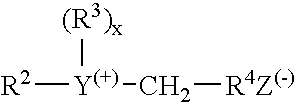Process for making low surfactant, high sugar bars
a surfactant and high sugar technology, applied in the field of bar compositions, can solve the problems of increased filler or other ingredients, increased mildness, and higher wear ra
- Summary
- Abstract
- Description
- Claims
- Application Information
AI Technical Summary
Benefits of technology
Problems solved by technology
Method used
Image
Examples
example 13
In order to show the dramatic difference between bars made according to the process of the invention (Tg modifier after neutralization) and bars made by process otherwise identical, except that glass modifier is added before neutralization, applicants conducted experiments as noted below:
Process for Making Sugar Bars
(1) Addition of Tg modifier before neutralization(a) approximately 17.58 g of water, 50.0 g of sugar, 10.0 g of Tg modifier (e.g., maltodextran) were mixed and then heated to approximately 85° C.;(b) once homogeneous, 12.5 g surfactants (e.g., lauric acid) was added and process temperature maintained;(c) surfactant was neutralized using 5.0 g NaOH;(d) minor ingredients (e.g., SDS, preservatives, perfume, TiO2) were added and;(e) soap bars were poured and cast.Results are seen in FIG. 1.(2) Addition of Tg modifier after neutralization:(a) 17.58 g water and 50.0 g of sugar were mixed and heated to 85° C.;(b) once homogeneous, 12.5 g surfactants (e.g., lauric acid) was adde...
PUM
| Property | Measurement | Unit |
|---|---|---|
| temperature | aaaaa | aaaaa |
| temperature | aaaaa | aaaaa |
| temperature | aaaaa | aaaaa |
Abstract
Description
Claims
Application Information
 Login to view more
Login to view more - R&D Engineer
- R&D Manager
- IP Professional
- Industry Leading Data Capabilities
- Powerful AI technology
- Patent DNA Extraction
Browse by: Latest US Patents, China's latest patents, Technical Efficacy Thesaurus, Application Domain, Technology Topic.
© 2024 PatSnap. All rights reserved.Legal|Privacy policy|Modern Slavery Act Transparency Statement|Sitemap



